You’ll love these soft, tender and chewy gluten-free bagels (no boiling or kneading required!). Topped with sesame seeds, these delicious bagels perfect toasted with sliced avocado, smoked salmon, or even with jam! Totally dairy-free too, but no one would care! Bake a large batch and freeze so you can enjoy homemade bagels anytime!

Want to save this recipe?
Enter your email & I’ll send it to your inbox. Plus, get great new recipes from me every week!
Jump to:
- Bagels: The Perfect Way to Start a Day
- Soft, Fluffy Gluten-Free Bagels
- Why This Recipe Works
- Ingredients You’ll Need:
- Ingredient Notes/Substitutions:
- How to Make Gluten-Free Bagels (No Boiling Required!
- Dish by Dish Tips/Tricks:
- Recipe FAQs:
- Yeast Bread Recipes You’ll Love:
- Gluten-Free Bread Recipes to Bake:
- Soft, Fluffy Gluten-Free Bagels (Dairy-Free, No-Boil)
Bagels: The Perfect Way to Start a Day
One favorite way to begin my day (especially during the weekend), is to sit down to a slow breakfast or brunch with a freshly baked bagel slathered with my favorite cream cheese and topped with smoked salmon and sliced avocado, along with fresh leafy greens by the side.
There’s just something so incredibly luxurious about biting into a homemade bagel, sipping on a hot cup of tea, and reading my Kindle, without anything else on the agenda.
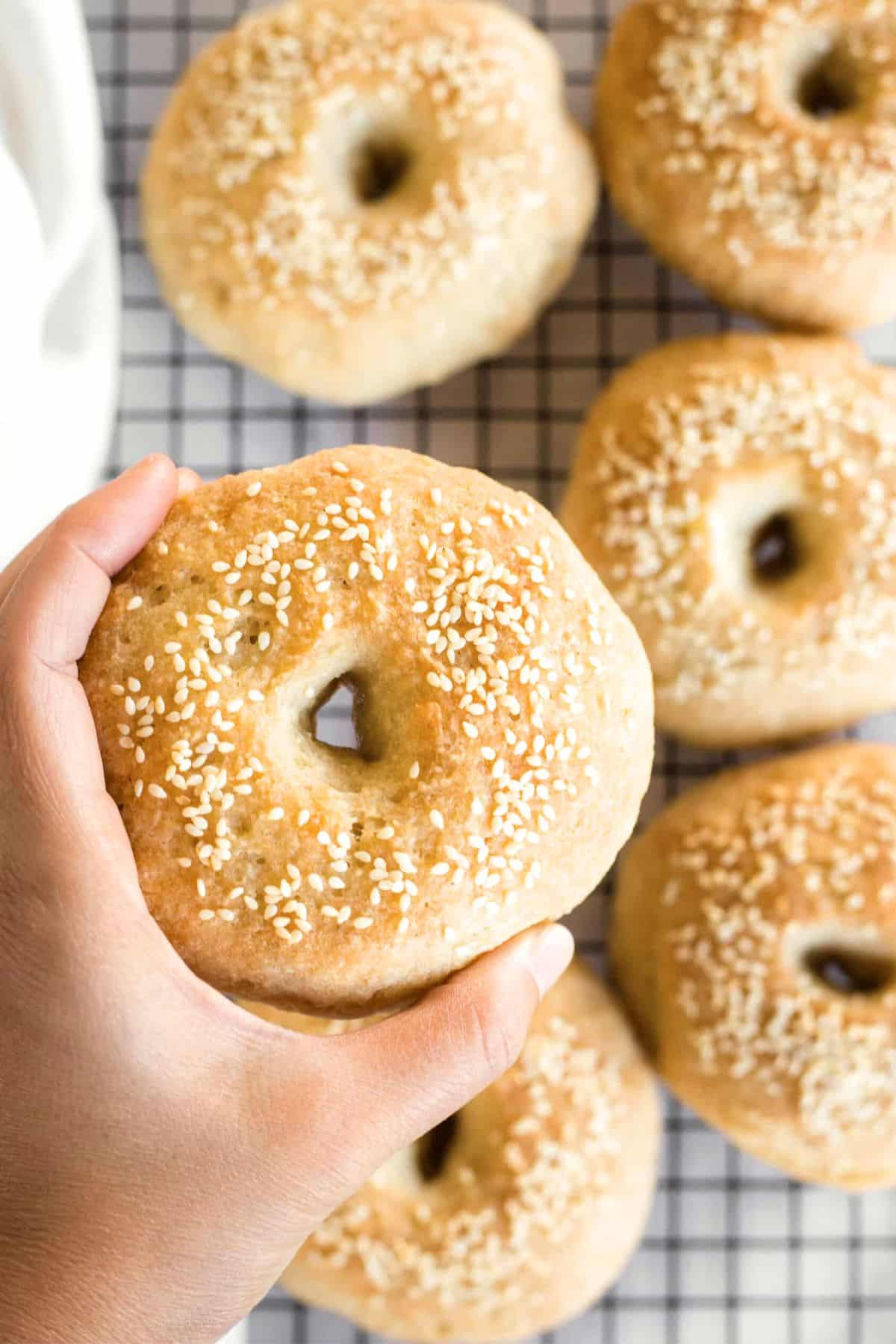
Soft, Fluffy Gluten-Free Bagels
Since I love baking homemade bread, I’ve had it on my mind to make homemade gluten-free bagels for the longest time.
However, most recipes require boiling the bagel dough in a large pot of boiling water, and since that sounds complicated, I usually skip them and never got around the making any.
In the last couple of months though, I’ve been tinkering around and testing various recipes (many of which have ended up directly in the trash).
However, my perseverance has paid off and I’m so happy to tell you that I’ve finally developed a great bagel recipe (adapted from my gluten-free potato bread recipe).
This recipe is no-boil, super easy to make, and most importantly, these gluten-free no-boil bagels are incredibly soft, tender and chewy inside!!
It’s honestly life-changing, and I can’t wait to share it with you! Ready to eat some fresh bagels? Let’s go!

Why This Recipe Works
- Simple Ingredients: The ingredients required for this gluten-free bagel recipe are easily accessible at the grocery store, and you might already have most of them on hand (nothing fancy required)!
- Easy to Make (No Boiling or Kneading Required!): These homemade gluten-free bagels are super simple to make, and there’s no need to boil the dough in a water bath at all! No kneading required either. Seriously, I’m not kidding!
- Amazing Texture: Slightly crusty on the outside, and incredibly soft, tender and chewy on the inside, these homemade gluten-free bagels are so good you can literally eat them on their own (hint: the secret ingredient is mashed potatoes)!
- Totally Gluten-Free & Dairy-Free: Traditional bagels usually use wheat flour, which means Celiacs can’t enjoy them. However, this delicious bagel recipe is 100% gluten-free and dairy-free, which means even those who have Celiac disease or gluten or lactose intolerances, or those simply on a gluten-free diet can enjoy the best gluten-free bagels without worries!
Ingredients You’ll Need:
Here’s a visual overview of the ingredients required for this gluten-free bagel recipe.
(For exact measurements, please scroll down to the printable recipe card at the bottom of this post.)

Ingredient Notes/Substitutions:
- Mashed Potatoes: I like using leftover mashed potatoes, but you can also use fresh mashed potatoes. Alternatively, you may used mashed sweet potatoes or mashed pumpkin puree as well.
- Eggs: Eggs help the ingredients to bind better and give the bagels better rise. I haven’t tried making this recipe without eggs, but I believe that if you are vegan or allergic to eggs, you may also use aquafaba or an egg-replacer (please let me know how it goes in the comments below if you make these bagels without eggs).
- Warm Water: Make sure the warm water has a temperature of between 105 to 115F. If the water is too cold, the yeast will not be activated, but if the water is too hot, the high heat will kill the yeast. Alternatively, if you prefer, you may also use warm non-dairy milk for extra flavor (such as almond milk, cashew milk, rice milk etc). If you are not lactose-intolerant, feel free to use normal cow’s milk instead.
- Sunflower Oil: I like using sunflower oil because I always have a bottle of it on hand. You may also use other types of vegetable oils such as olive oil, avocado oil, melted coconut oil or even melted vegan butter. Alternatively, if you are not lactose-intolerant, feel free to use melted normal butter if you prefer.
- Gluten-Free All-Purpose Flour: I recommend using a good-quality gluten-free all-purpose flour blend that includes lighter flours/starches (such as rice flour, corn starch, tapioca starch or potato starch) to ensure that you get a light and fluffy final texture. I do NOT recommend using gluten-free flour blends that use heavier flours (such as garbanzo bean flour) as it will result in a denser texture.
- Xanthan Gum: Xanthan gum is the replacement for gluten in gluten-free flours, and helps the ingredients to better bind together. If your gluten-free flour blend does not already include xanthan gum, make sure you add it in.
- Psyllium Husk Powder: Pysllium husk powder is an amazing binding agent and makes a big difference in the rise of the bagels. For best results, I do NOT recommend leaving it out or swapping it out for anything else. If you only have access to whole psyllium husks, you can use a coffee grinder or a high-speed blender to grind the husks into a super fine powder.
- Baking Powder: I like adding a bit of baking powder to help the bagel dough rise better. If have Celiac disease or are gluten-intolerant, make sure to use certified gluten-free baking powder.
- Instant Yeast: I prefer using instant yeast because there’s not pre-activation required, and you can mix it in with all the other dry ingredients at the same time. However, if you don’t have instant yeast, you may also use active dry yeast instead (just make sure to activate the yeast with sugar and warm water before adding it to the other ingredients).
- Sugar: In this case, sugar acts as the food that the yeast will feed on in order to produce the gases essential in the dough-rising process. Do not leave out the sugar. It will be consumed by the yeast and will not make the bagels sweet. I used granulated white sugar, but you may also use light brown sugar, or brown sugar if you prefer (just note that the darker the color of the sugar, the darker the interior of the bagels).
- Salt: I added a pinch of salt to enhance the flavor, but feel free to leave it out if you are on a salt-free diet.
- Sesame Seeds: I like sprinkling white sesame seeds to decorate the bagels, but you can also sprinkle the bagel dough with a mix of seeds (think chia seeds, flax seeds, sesame seeds and sunflower seeds). You can also use everything bagel seasoning if you prefer.
How to Make Gluten-Free Bagels (No Boiling Required!
1. Line Baking Sheet
Line a large baking sheet with parchment paper or a silpat.
2. Whisk Dry Ingredients
In a large bowl, sift the gluten-free all-purpose flour, xanthan gum, psyllium husk powder, baking powder, instant yeast, sugar and salt together. Whisk well to combine.

3. Blend Potatoes and Eggs
Process the mashed potatoes and beaten eggs in a high-speed blender until you get a thick, creamy yellow mixture.

4. Add Water and Oil
Transfer the potato-egg mixture to a large mixing bowl. Add the water and oil and mix well to get a pale yellow liquid mixture.

5. Form the Dough
Add the dry ingredients to the bowl with the wet ingredients and mix well until you get a homogeneous sticky dough (the dough will look shaggy and be rather wet, but that’s the texture you want).

6. Shape Dough Balls
Oil the palms of your hands and divide the dough into 6 equal portions, rolling each portion into a large ball. Place the dough balls at least 2 inches apart on the prepared baking sheet.

7. Flatten Balls and Poke a Hole
To create the bagel shape, flatten the balls with your oiled fingers and and use an oiled chopstick or finger to poke a hole in the middle of the dough circles.

8. Let Rise
Cover the baking sheet with a kitchen towel and let the dough rise in a warm place for 1 hour until the dough has almost doubled in size.
(Tip: Depending on how warm and humid your kitchen, the dough may take less or more time to rise.)
9. Preheat Oven
Towards the end of the rising time, preheat the oven to 350F and place the rack in the center position.
10. Brush Dough with Oil
Brush the risen dough will oil.
(Alternatively, if you prefer not to use oil, you may brush the bagel dough with egg whites instead.)

11. Sprinkle with Seeds
Sprinkle sesame seeds on top of the dough.

12. Bake Until Golden Brown
Bake for 25 to 30 minutes until the top of the bagels are golden brown.

13. Let Cool Before Slicing
Allow these chewy gluten-free dairy-free bagels to cool for a 5 minutes in the pan before removing and placing a wire rack to cool fully at room temperature before slicing.

Dish by Dish Tips/Tricks:
- Change Out the Topping: I like sprinkling white sesame seeds to decorate the bagels, but you can also sprinkle the bagel dough with a mix of seeds (think chia seeds, flax seeds, black sesame seeds, poppy seeds or sunflower seeds), gluten-free oats or sea salt. You can also use everything bagel seasoning if you prefer.
- Make Buns: If you prefer, you can also use the same dough to make gluten-free buns instead. Simply roll the dough into even sized balls without poking a hole in the middle, and bake for 25 to 30 minutes until buns golden brown.
- Add More Fiber: Feel free to swap out 1/2 cup of gluten-free all-purpose flour with brown rice flour, sorghum flour, millet flour, buckwheat flour or amaranth flour for a more “whole grain”bagel.
- Line Baking Sheet: Make sure to line the baking sheet with either parchment paper or a silpat so the bagel dough doesn’t stick to the sheet, and it’ll be easier to remove the bagels once baked.
- Toast for Crispy Texture: You can also slice the bagels into half horizontally and toast them before spreading with cream cheese or whatever you like.
Recipe FAQs:
To store, place the cooled bagels in an airtight container and store in the refrigerator for up to 5 days.
Yes you can! To freeze, wrap the gluten-free dairy-free bagels in plastic wrap and place in the freezer for up to 3 months. Before eating, let the frozen bagels thaw overnight in the refrigerator, or you can reheat them in the oven for 5 minutes at 350F.

Yeast Bread Recipes You’ll Love:
- No Knead Artisan Bread (Gluten-Free, Dairy-Free)
- Soft Fluffy Potato Bread (Gluten-Free, Dairy-Free)
- Tender Hamburger Buns (Gluten-Free, Dairy-Free)
- Easy Slider Buns (Gluten-Free, Dairy-Free)
- Soft Gluten-Free Dinner Rolls (Dairy-Free)
- Brown Rice Bread (Gluten-Free, Dairy-Free)
- Quinoa Bread (Gluten-Free, Dairy-Free)
- Gluten-Free Bread (Dairy-Free)
Gluten-Free Bread Recipes to Bake:
P.S. If you try this recipe, I’d love for you to leave a star rating below, and/or a review in the comment section further down the page. I always appreciate your feedback. Be sure to check out my entire Recipe Index for all the recipes on the blog. You can also follow me on Pinterest, Facebook or Instagram! Sign up for my Email List to get fresh recipes in your inbox each week!
Print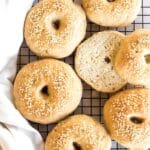
Soft, Fluffy Gluten-Free Bagels (Dairy-Free, No-Boil)
- Total Time: 1 hour 50 minutes
- Yield: 6 servings 1x
- Diet: Gluten Free
Description
You’ll love these soft, tender and chewy gluten-free bagels (no boiling or kneading required!). Topped with sesame seeds, these delicious bagels perfect toasted and eaten with sliced avocado, smoked salmon, or even with jam! Totally dairy-free too, but no one would care! Bake a large batch and freeze so you can enjoy homemade bagels anytime!
Ingredients
- 1 cup mashed potatoes
- 2 large eggs, beaten
- 1 cup warm water (between 105 to 115F)
- 1/4 cup sunflower oil + more for brushing
- 2 1/4 cups gluten-free all-purpose flour
- 1 teaspoon xanthan gum (omit if your flour blend already includes it)
- 2 tablespoons psyllium husk powder
- 1 teaspoon baking powder
- 2 1/4 teaspoons instant yeast
- 1 tablespoon sugar
- 1/4 teaspoon salt
- 1 tablespoon sesame seeds (optional)
Instructions
- Line: Line a large baking sheet with parchment paper or a silpat.
- Whisk Dry Ingredients: In a large bowl, sift the gluten-free all-purpose flour, xanthan gum, psyllium husk powder, baking powder, instant yeast, sugar and salt together. Whisk well to combine.
- Blend: Process the mashed potatoes and beaten eggs in a high-speed blender until you get a thick, creamy yellow mixture.
- Add Water and Oil: Transfer the potato-egg mixture to a large mixing bowl. Add the water and oil and mix well to get a pale yellow liquid mixture.
- Form the Dough: Add the dry ingredients to the bowl with the wet ingredients and mix well until you get a homogeneous sticky dough (the dough will look shaggy and be rather wet, but that’s the texture you want).
- Form Dough Balls: Oil the palms of your hands and divide the dough into 6 equal portions, rolling each portion into a large ball. Place the dough balls at least 2 inches apart on the prepared baking sheet.
- Flatten Balls and Poke a Hole in the Middle: Flatten the balls with your oiled fingers and and use an oiled chopstick or finger to poke a hole in the middle of the dough circles.
- Let Rise: Cover the baking sheet with a kitchen towel and let the dough rise in a warm, draft-free place for 1 hour until it has almost doubled in size.
- Preheat Oven: Towards the end of the rising time, preheat the oven to 350F and place the rack in the center position.
- Brush with Oil: Brush the risen dough will oil.
- Sprinkle with Seeds: Sprinkle sesame seeds on top of the dough.
- Bake Until Golden Brown: Bake for 25 to 30 minutes until the top of the bagels are golden brown.
- Let Cool Before Slicing: Allow the bagels to cool for a 5 minutes in the pan before removing and placing a wire rack to cool fully at room temperature before slicing.
Notes
Mashed Potatoes: I like using leftover mashed potatoes, but you can also use fresh mashed potatoes. Alternatively, you may used mashed sweet potatoes or mashed pumpkin puree as well.
Eggs: Eggs help the ingredients to bind better and give the bagels better rise. I haven’t tried making this recipe without eggs, but I believe that if you are vegan or allergic to eggs, you may also use aquafaba or an egg-replacer (please let me know how it goes in the comments below if you make these bagels without eggs).
Warm Water: Make sure the warm water has a temperature of between 105 to 115F. If the water is too cold, the yeast will not be activated, but if the water is too hot, the high heat will kill the yeast. Alternatively, if you prefer, you may also use warm non-dairy milk for extra flavor (such as almond milk, cashew milk, rice milk etc). If you are not lactose-intolerant, feel free to use normal cow’s milk instead.
Sunflower Oil: I like using sunflower oil because I always have a bottle of it on hand. You may also use other types of vegetable oils such as olive oil, avocado oil, melted coconut oil or even melted vegan butter. Alternatively, if you are not lactose-intolerant, feel free to use melted normal butter if you prefer.
Gluten-Free All-Purpose Flour: I recommend using a good-quality gluten-free all-purpose flour blend that includes lighter flours/starches (such as rice flour, corn starch, tapioca starch or potato starch) to ensure that you get a light and fluffy final texture. I do NOT recommend using gluten-free flour blends that use heavier flours (such as garbanzo bean flour) as it will result in a denser texture.
Xanthan Gum: Xanthan gum is the replacement for gluten in gluten-free flours, and helps the ingredients to better bind together. If your gluten-free flour blend does not already include xanthan gum, make sure you add it in.
Psyllium Husk Powder: Pysllium husk powder is an amazing binding agent and makes a big difference in the rise of the bagels. For best results, I do NOT recommend leaving it out or swapping it out for anything else. If you only have access to whole psyllium husks, you can use a coffee grinder or a high-speed blender to grind the husks into a super fine powder.
Baking Powder: I like adding a bit of baking powder to help the bagels rise better. If have Celiac disease or are gluten-intolerant, make sure to use certified gluten-free baking powder.
Instant Yeast: I prefer using instant yeast because there’s not pre-activation required, and you can mix it in with all the other dry ingredients at the same time. However, if you don’t have instant yeast, you may also use active dry yeast instead (just make sure to activate the yeast with sugar and warm water before adding it to the other ingredients).
Sugar: In this case, sugar acts as the food that the yeast will feed on in order to produce the gases essential in the dough-rising process. Do not leave out the sugar. It will be consumed by the yeast and will not make the bagels sweet. I used granulated white sugar, but you may also use light brown sugar, or brown sugar if you prefer (just note that the darker the color of the sugar, the darker the interior of the bagels).
Salt: I added a pinch of salt to enhance the flavor, but feel free to leave it out if you are on a salt-free diet.
Sesame Seeds: I like sprinkling white sesame seeds to decorate the bagels, but you can also sprinkle the bagel dough with a mix of seeds (think chia seeds, flax seeds, sesame seeds and sunflower seeds). You can also use everything bagel seasoning if you prefer.
Storing/Freezing: To store, place the cooled bagels in an airtight container and store in the refrigerator for up to 5 days. To freeze, wrap the gluten-free bagels in plastic wrap and freeze for up to 3 months. Before eating, let the frozen bagels thaw overnight in the refrigerator, or you can reheat them in the oven for 5 minutes at 350F.
- Prep Time: 20 mins
- Rising Time: 1 hour
- Cook Time: 30 mins
- Category: Bread
- Method: Baking
- Cuisine: American

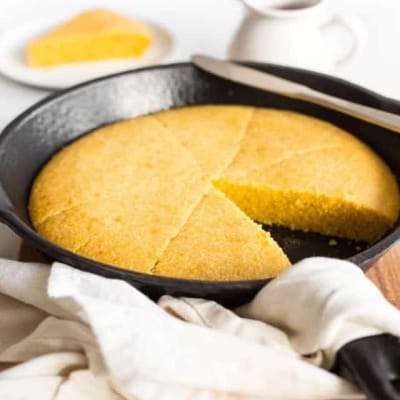
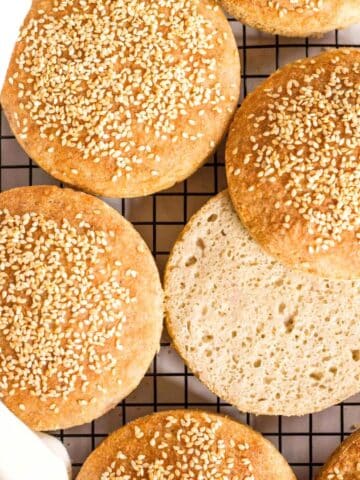
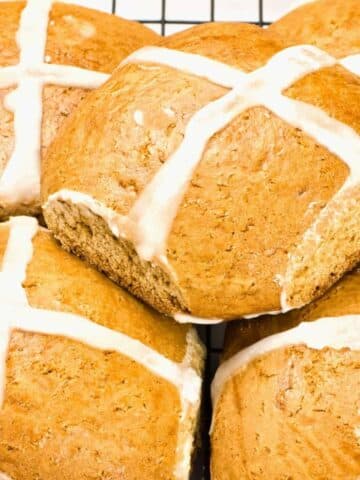
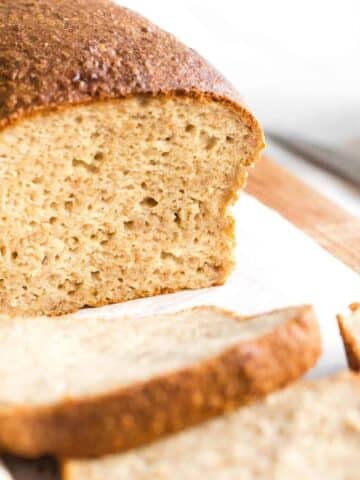
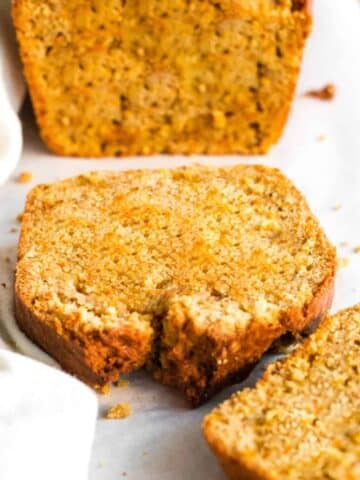
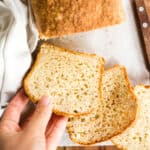
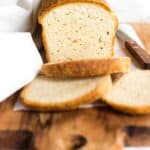

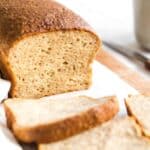
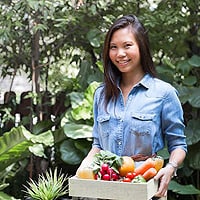
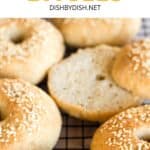
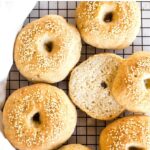
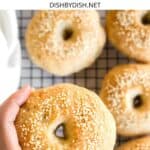
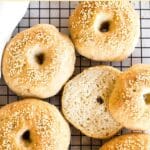

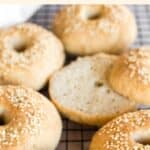
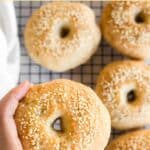
Hi Felicia just wondering if I could leave out the potatoes or what can I substitute with
Hi Banu! In this case, the mashed potatoes are an essential ingredient. If you are not allergic to potatoes, I would highly suggest that you use it. Instant mashed potatoes will work too if you don’t want to make mashed potatoes from scratch.
OK, made these today and they came out pretty good. I did of course substitute EQUAL Amounts of Glucomannon for the Psyllium Husk Powder, because that causes stomach problems for me. The Glucomannon actually makes all your goods have a little bit more rise to them, but that’s OK. I doubled the recipe & used 3 silicone large donut molds for my bagels and they looked so beautiful, I could cry. I sprinkled Black Sesame Seeds on half & White Sesame Seeds on the other half, after putting an egg wash on them. I plan to freeze several of them. I recently made your hamburger bun recipe, but they dried a little bit, when I froze them. So, I’d like to freeze these and if they come out a little softer, I’d like using some of these bagels as buns for hamburgers and sandwiches. I’ve made your Soft Bread Recipe several times and it’s always soft, even after being frozen. So, I believe I’m going to take that recipe and make Hot Dog and Hamburger Buns in my silicone molds with it, as well. I know it’s a wet recipe, but I just keep a bowl of warm water handy and dip my hands in. That’s how I smooth the tops of my breads, too. It works better for me, than trying to use a spatula. Love your recipes. I’ve tried dozens of online Bread recipes and most were HEAVY or were like Styrofoam. Your recipes are so much lighter, actually edible and closer to regular breads.
Thank you so much for your kind words and feedback Delight! Glad you really enjoy the soft fluffy gf bread recipe and that you’ll use it for making hot dog buns and burger buns too! Makes me so happy to know that you really enjoy my bread recipes – they’re a labor of love! Have a lovely week and I hope to see you around the blog again sometime soon!
xx,
felicia
do the mashed potatoes have to be prepped with butter and milk? Or can I just microwave potatoes until soft and mash them?
Hi Kirsten, you can just microwave the potatoes until soft and mash them 🙂
Thank you Felicia!
These Bagels are superb when eaten with our favourite complementary add-ons to be sandwiched between. I guess they will go well with almost anything I like to eat them with.
I realy love your recipe post for its versatility and inclusiveness that anyone can use because you shared with us all the various interchangeability of the ingredients to meet the different groups of people with different intolerances.
Thank you again for your thoughfulness of the needs of others – I applaud you!
Sending you love and blessings from Singapore,
Mum
Hi mummy, these bagels are really delicious, and I’m soooo happy I finally nailed this GF bagel recipe!